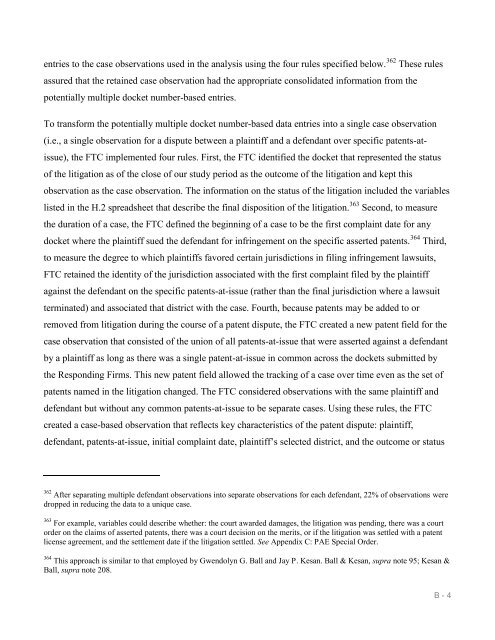Create successful ePaper yourself
Turn your PDF publications into a flip-book with our unique Google optimized e-Paper software.
entries to the case observations used in the analysis using the four rules specified below. 362 These rules<br />
assured that the retained case observation had the appropriate consolidated information from the<br />
potentially multiple docket number-based entries.<br />
To transform the potentially multiple docket number-based data entries into a single case observation<br />
(i.e., a single observation for a dispute between a plaintiff and a defendant over specific patents-atissue),<br />
the FTC implemented four rules. First, the FTC identified the docket that represented the status<br />
of the litigation as of the close of our study period as the outcome of the litigation and kept this<br />
observation as the case observation. The information on the status of the litigation included the variables<br />
listed in the H.2 spreadsheet that describe the final disposition of the litigation. 363 Second, to measure<br />
the duration of a case, the FTC defined the beginning of a case to be the first complaint date for any<br />
docket where the plaintiff sued the defendant for infringement on the specific asserted patents. 364 Third,<br />
to measure the degree to which plaintiffs favored certain jurisdictions in filing infringement lawsuits,<br />
FTC retained the identity of the jurisdiction associated with the first complaint filed by the plaintiff<br />
against the defendant on the specific patents-at-issue (rather than the final jurisdiction where a lawsuit<br />
terminated) and associated that district with the case. Fourth, because patents may be added to or<br />
removed from litigation during the course of a patent dispute, the FTC created a new patent field for the<br />
case observation that consisted of the union of all patents-at-issue that were asserted against a defendant<br />
by a plaintiff as long as there was a single patent-at-issue in common across the dockets submitted by<br />
the Responding Firms. This new patent field allowed the tracking of a case over time even as the set of<br />
patents named in the litigation changed. The FTC considered observations with the same plaintiff and<br />
defendant but without any common patents-at-issue to be separate cases. Using these rules, the FTC<br />
created a case-based observation that reflects key characteristics of the patent dispute: plaintiff,<br />
defendant, patents-at-issue, initial complaint date, plaintiff’s selected district, and the outcome or status<br />
362<br />
After separating multiple defendant observations into separate observations for each defendant, 22% of observations were<br />
dropped in reducing the data to a unique case.<br />
363<br />
For example, variables could describe whether: the court awarded damages, the litigation was pending, there was a court<br />
order on the claims of asserted patents, there was a court decision on the merits, or if the litigation was settled with a patent<br />
license agreement, and the settlement date if the litigation settled. See Appendix C: PAE Special Order.<br />
364<br />
This approach is similar to that employed by Gwendolyn G. Ball and Jay P. Kesan. Ball & Kesan, supra note 95; Kesan &<br />
Ball, supra note 208.<br />
B - 4


